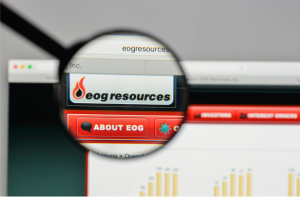
The energy sector is going through a dramatic shift, which has roiled stocks throughout the industry. The global focus on reducing carbon emissions has catalyzed a general shift away from fossil fuels and toward cleaner energy generation.
However, that shift will be gradual, and will take time to fully materialize. Accordingly, in the meantime, investors stand to benefit from valuation mismatches in the market, when considering both fossil fuel and clean energy stocks. Indeed, the energy sector is one that likely won’t be steady and predictable. Last year highlighted this idea, as investors watched as oil prices and profits spike for oil producers, and many green energy stocks showed similar volatility.
For those looking to take advantage of this volatility and buy some discounted energy stocks, here are seven great options to consider.
ConocoPhillips (COP)

ConocoPhillips (NYSE:COP) is among the “old guard” within the energy sector. It’s one of the more prominent names in energy production, and currently offers great upside due to a number of factors.
The Houston-based firm touches the entirety of the value and supply chain for oil and gas. ConocoPhillips engages in all things oil and gas, including exploration, production, transportation, and marketing. Volatility has afflicted the oil and gas side of the energy market in particular in 2023. Prices have fallen, and the bonanza that was 2022 no longer exists.
However, despite the sea change, ConocoPhillips has deftly managed through the turbulence.The company’s Q1 ‘23 adjusted earnings of $2.38 per share came in better than what Wall Street was expecting. That was a welcome piece of news, as revenues fall across the industry (and at ConocoPhillips) in the first quarter.
Strong fundamentals at ConocoPhilips are suggestive of significant underlying value in COP stock. Shares have roughly $18 of upside beyond their current $113 price based on Wall Street’s expectations. That doesn’t account for the dividend distribution of $2.40 annually, pushing the stock’s total return a few percentage points higher.
Northwest Natural Holding (NWN)

Depending on who you ask, Northwest Natural Holding (NYSE:NWN) stock appears to be undervalued by roughly $10 to $20. It is a gas and water utility company serving customers throughout Oregon and southwest Washington state. Its water segment serves customers in Arizona and Texas.
One of the easiest ways to understand the value of Northwest Natural Holding is to look at market cyclicality as it applies to utility firms. Utility companies like Northwest Natural Holding don’t have much room to absorb higher input prices when inflation rises. Additionally, customers complain very vocally when their utility rates rise. That generally means utility firms have to absorb increased prices during inflationary periods ,without the luxury of passing those increases to customers. The result is weaker earnings and lower prices.
That’s what is happening to Northwest Natural Holding right now. Currently, NWN stock is trading near prices it last saw around 2013. That said, I think this is among the utility stocks that should rebound as cyclicality runs its course. The company provides investors with a rock-solid dividend that was last reduced in 1956, and currently yields 4.5%.
EOG Resources (EOG)

EOG Resources (NYSE:EOG) is an upstream oil & gas firm that offers tremendous upside based on its profitable and sustainable business operations.
Those operations span the U.S., Trinidad, China, and Canada. What I particularly like about EOG’s business model is that it is very steady. Over the past year, the company has produced approximately $1 of earnings per every $3 of revenue. That ratio has held very steady over the longer-term.
The company generated $1.1 billion in free cash flow during the period, which it used to pay dividends and repurchase $310 million of shares in Q1.
EOG Resource’s dividend is also quite reliable. It hasn’t been reduced since 2001, and has a payout ratio of 0.19. That means 19% of the company’s net income is being allocated to dividends. For context, that’s a very low ratio, suggesting plenty of room for dividend hikes over time, which should buoy the value of EOG stock over the long-term.
Enphase Energy (ENPH)

Enphase Energy (NASDAQ:ENPH) manufactures and sells solar micro inverters across the globe. And like the other stocks on this list, is currently trading at levels I would call very undervalued.
More accurately, ENPH stock has upside of roughly 50%, or perhaps by more than 100%, depending on who is judging its merits.
Now, Enphase Energy is undervalued not because of its fundamental performance to date. In that regard, the company has done very well through the first quarter. Revenue increased from $441.3 million to $726.02 million in Q1 on a year-over-year basis. Additionally, the company’s net income nearly tripled to $146.87 million during the same period. Fundamentally speaking, Enphase Energy has done very well.
However, residential solar demand concerns in the U.S. have caused investors concern. Rising interest rates are hurting the economic case behind green energy adoption. Rising interest rates and low utility rates have combined to make solar investments less attractive.
That said, I think Enphase Energy is a great bet for those taking a long-term view of this sector. The company is growing strong in core markets like Europe, with revenues increasing by 25% during the previous quarter.
Clearway Energy (CWEN)

Clearway Energy (NYSE:CWEN) stock is roughly 50% cheaper than it was a year ago. That discount, combined with several other factors, puts CWEN shares in the bargain bin right now.
There are a few salient factors that make me feel optimistic about the company. First of all, Clearway Energy is quite large, boasting a portfolio of more than 5.7 gigawatts of energy production spanning wind, solar, and energy storage. For the sake of comparison, Hoover Dam has a capacity of 2 gigawatts.
Secondly, Clearway Energy is well-positioned to reward investors. The company sold its thermal business a year ago, providing excess capital reserves which can be deployed. While these funds may be poured into interesting new projects, it’s also possible that shareholders could be rewarded with greater share repurchases or dividends over time. In either case, I like the financial flexibility this company has.
Indeed, Clearway has shown it remains intent on rewarding shareholders via dividends. Currently, CWEN stock provides a dividend yield of 5.8%. That dividend has grown at a rate of 5.1% over the last 5 years. Management has stated that it intends to continue to grow it at a rate of 5-8% through 2028.
Halliburton (HAL)

One of the primary reasons to invest in Halliburton (NYSE:HAL) is the fact that U.S. oil production is expected to rise more than it was previously.
Halliburton provides a range of services and around the exploration and production within the energy industry. So, when production is expected to spike to meet demand, it is then logical to anticipate that Halliburton will benefit.
However, Halliburton’s opportunity doesn’t look to be limited to 2023 alone. The firm reported roughly $20.3 billion in revenue in 2022. That figure is expected to jump to $23.7 billion this year and rise to $25.8 billion in 2024.
When demand rises in a given industry, picks-and-shovels stocks like Halliburton make a lot of sense. Investing in individual exploration firms can be hit or miss. However, Halliburton gets to spread its risk across all of its partners, and will be able to take advantage of the production boom that is coming.
Bloom Energy (BE)

There is no doubt that Bloom Energy (NYSE:BE) is one of the riskier stocks in the energy sector. Its 2.86 beta means it rises and falls much quicker than the average stock. That’s arguably a good thing, given that BE stock trades at levels at which they’ve rebounded over the past few years.
One reason to believe that Bloom Energy will continue to rebound is that top-line growth is expected to pick up. The company reported $1.2 billion in sales in 2022 which is expected to grow to $1.47 billion this year and $1.91 billion by the end of 2024.
It’s difficult to argue that Bloom Energy shares won’t appreciate in value if sales increase by nearly 60%. And that’s exactly what is expected over the next two years.
Revenues grew by 37% in the most recent quarter, and the company’s losses per share narrowed from 32 cents to 22 cents. Overall, losses aren’t helping BE stock at this juncture. But I do think the company is making the right strides toward profitability. If that progress is rewarded by the market, shareholders stand to benefit by getting in now.
On the date of publication, Alex Sirois did not have (either directly or indirectly) any positions in the securities mentioned in this article. The opinions expressed in this article are those of the writer, subject to the InvestorPlace.com Publishing Guidelines.




